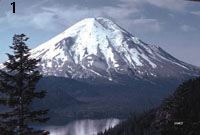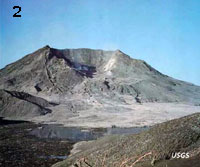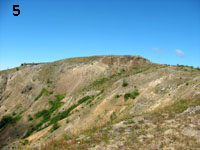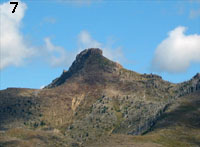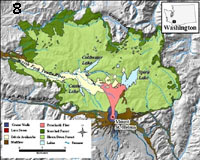The blast zone
Before the eruption, Mt St Helens (named for British diplomat Alleyne Fitzherbert, whose title was Baron St. Helens) had a majestic, symmetrical cone (fig.1), which formed the backdrop for a poplular resort at Spirit Lake. After the eruption (fig. 2) the top of the cone had been removed, reducing the height of the mountain from 2951 m to 2551 m. Volume removed was about 2.5 km3. Much of this material was transferred to the north and west as debris avalanche, pyroclastic, and lahar deposits (fig. 3 and 4). As much as 520 million tons of ash was spread eastward by prevailing winds -- Spokane was completely darkened.
The area immediately to the north of the crater, now named Johnston Ridge in memory of USGS geologicst David Johnston who was killed there, received the main force of the lateral blast. All of the trees were blown over and much of the soil was stripped off (fig. 5, 6). The blast was ground-hugging and passed up and down hill. Velocities were as much as 300 miles per hour, slowing as the blast spread out; temperatures were as high as 350oC.
All trees were blown down in a wide swath of the area north of the volcano (fig.7), with a narrower border of burned trees outlining this zone (fig. 8). The evacuation zone that had been established prior to the eruption extended for 5 to 15 km around the summit, but the lateral blast extended 20 to 25 km, catching many victims in what were believed to be relatively safe positions. Harrowing descriptions from eyewitnesses who survived the blast can be found in the book Echoes of Fury by Frank Parchman (Epicenter Press 2005).
Controversy exists over the mechanisms of transport and deposition, centering on whether the flow had a high or low concentration of particles. This uncertainty is reflected in the number of different names given to the flow. Some are "blast flow," "pyroclastic surge," and "pyroclastic density flow." The material propelled by the blast was mostly in the sand size (fig. 9) and was highly abrasive. Above a basal layer of reworked soil and wood debris, the deposits fine upwards, in response to waning flow velocity with time. (fig. 10)
Subsequent work on other blast deposits at Bezymianny and Soufriere Hills, combined with the St Helens observations suggests the following about lateral blasts (Belousov et al., 2007):
(1) The blasts are triggered by rapid decompression of a shallow magma body caused by sector failure of the volcanic edifice. That is the blast is provoked by the collapse and not vice versa.
(2) Material in the blast deposit is dominantly "juvenile", that is, derived from the magma, rather than "accidental", that is rocks and soil picked up by the blast. For St Helens, the juvenile component is 62%.
(3) The vesicularity of the juvenile material is low,about 30% for St Helens, indicating that degassed and chilled material from the margins of the magma body are a dominant component.
References [click to see list]
 fig9_600.html |
 fig10_600.html |

